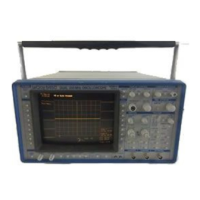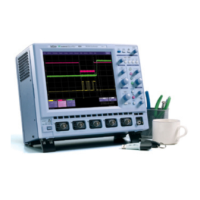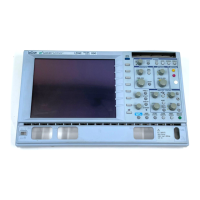|
|
Waveform Structure 6
|
|
|
WAVEFORM COMMAND
where the RIS_OFFSET’s can be found in the RISTIME array.
There can be up to 100 8 byte double precision floating point num-
bers in this block. The instrument tries to get segments with times
such that
RIS_OFFSET[i] ~ PIXEL_OFFSET + (i - 0.5) * HORIZ_IN
TERVAL
Thus, taking as an example a RIS with SWEEPS PER_ACQ = 10
HORIZ_INTERVAL = 1 ns and PIXEL_OFFSET = 0.0, we might
find for a particular event that:
RIS_OFFSET[0] ---0.5 ns
RIS_OFFSET[2] = 1.6 ns
RIS_OFFSET[4] = 3.4 ns
RIS_OFFSET[6] -- 5.6 ns
RIS_OFFSET[8] -- 7.6 ns
and therefore:
x[0] = RIS_OFFSET[0] =
x[1] = RIS_OFFSET[1] =
x[9] = RIS_OFFSET[9] =
x[lO] = 1 ns * 10 + (-0.5)
x[11] = 1 ns * 10 + 0.4 =
x[19] = 1 ns * 10 + 8.5 =
x[20] = 1 ns * 20 + (-0.5)
RIS_OFFSET[1] = 0.4 ns
RIS_OFFSET[3] = 2.6 ns
RIS_OFFSET[5] = 4.5 ns
RIS_OFFSET[7] -- 6.4 ns
RIS_OFFSET[9] = 8.5 ns
-0.5 ns
0.4 ns
8.5 ns
9.5 ns
10.4 ns
18.5 ns
19.5 ns
Waveforms that have been read in their entirety with the WAVE-
FORM? command can be sent back into the instrument. Since the
descriptor contains all of the necessary information, you do not
have to be careful about any of the communication format param-
eters. The instrument can learn all that it needs to know from the
waveform.
If you want to synthesize waveforms for display or comparison pur-
poses, you are encouraged to read out a waveform of the
appropriate size and then replace the data with the desired values.
This will assure that the descriptor is coherent.
Note: You are only allowed to send back waveforms to memory
traces (MC or MD for 2-channel instruments or MC, MD, FE
and FF for 4-channel instruments). This means that you may
have to remove or change the prefix (C1 or CHANNEL_l) in the
response to the WF? query. The examples for the WF command in
Section 5 show how this can be done.
187

